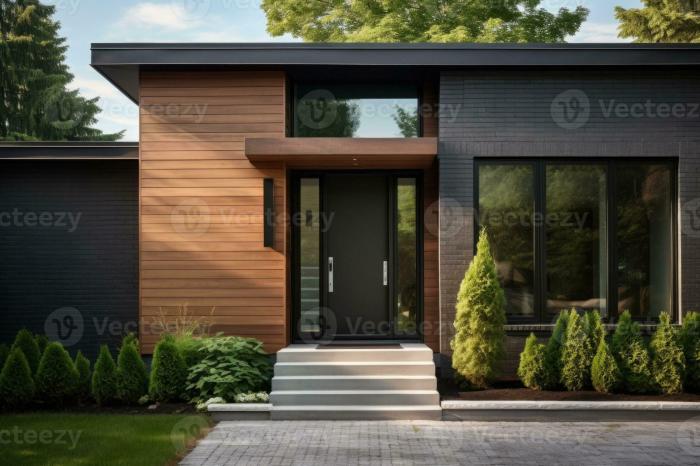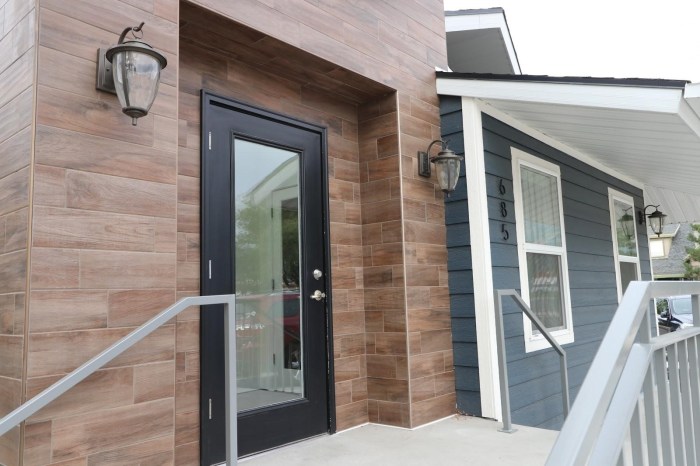Exploring Tile Siding Exterior for Your Architectural Needs
Embark on a journey through the world of tile siding exterior, discovering its role in architecture and the array of benefits it offers. From materials used to installation techniques, this topic delves deep into the realm of exterior design.
As we navigate through the intricacies of tile siding exteriors, we uncover the secrets behind their maintenance, design possibilities, and much more.
Introduction to Tile Siding Exterior

Tile siding exterior refers to the use of tiles as a cladding material for the exterior walls of buildings. This architectural element serves both functional and aesthetic purposes, enhancing the overall look and durability of a structure.
There are several benefits to using tile siding for exterior applications. One of the main advantages is its durability and resistance to harsh weather conditions, including rain, snow, and UV rays. Additionally, tile siding is low maintenance, easy to clean, and can last for many years without needing replacement.
Types of Materials Used for Tile Siding Exteriors
- Ceramic Tiles: Known for their versatility and wide range of colors and designs, ceramic tiles are a popular choice for tile siding exteriors.
- Natural Stone Tiles: Offering a more rustic and natural look, natural stone tiles are durable and add a touch of elegance to the exterior of a building.
- Porcelain Tiles: Porcelain tiles are highly resistant to moisture and are ideal for areas with high humidity levels, making them a suitable option for tile siding exteriors.
Installation of Tile Siding Exterior
Installing tile siding on an exterior surface requires careful planning and attention to detail to ensure a durable and long-lasting finish. Compared to other types of exterior cladding, tile siding offers a unique aesthetic appeal and can significantly enhance the curb appeal of a property.
Here, we will discuss the step-by-step process of installing tile siding, compare it with other cladding options, and explore best practices for achieving a high-quality tile siding exterior.
Step-by-Step Installation Process
- Prepare the exterior surface by cleaning and leveling it to ensure a smooth base for the tile siding.
- Apply a waterproof barrier or membrane to protect the underlying structure from moisture damage.
- Install corner pieces and trim to create clean edges and transitions between different sections of the siding.
- Begin laying the tiles from the bottom up, using mortar or adhesive to secure them to the surface.
- Ensure proper spacing between tiles for expansion and contraction, especially in areas with temperature variations.
- Grout the joints between tiles to provide a uniform appearance and improve weather resistance.
- Finish the installation by sealing the grout and tiles to enhance durability and protect against staining.
Comparison with Other Cladding Options
- Tile siding offers a more customizable and visually appealing option compared to vinyl or aluminum siding.
- While more labor-intensive to install, tile siding provides better insulation and weather resistance than wood or fiber cement siding.
- Unlike brick or stone siding, tile siding allows for a wider range of colors, patterns, and textures to suit different architectural styles.
Best Practices for Long-Lasting Tile Siding
- Choose high-quality tiles that are designed for exterior use and can withstand the local climate conditions.
- Properly seal and maintain the grout lines to prevent water infiltration and ensure the structural integrity of the siding.
- Regularly inspect the tile siding for any damage or signs of wear, and address any issues promptly to prevent further deterioration.
Maintenance and Care of Tile Siding Exterior

Proper maintenance and care are essential to ensure the longevity and appearance of your tile siding exterior
Cleaning and Maintenance Tips
- Regularly wash the tile siding with a mixture of mild soap and water to remove dirt and grime.
- Avoid using harsh chemicals or abrasive materials that could damage the tiles.
- Inspect the siding for any cracks, chips, or loose tiles, and repair them promptly to prevent further damage.
- Seal the grout between tiles to prevent moisture infiltration and potential mold growth.
- Trim any vegetation or trees near the siding to prevent damage from branches or roots.
Common Issues and Solutions
- Cracked or chipped tiles: Replace damaged tiles with new ones to maintain the integrity of the siding.
- Mold or mildew growth: Clean affected areas with a solution of water and vinegar to prevent further spread.
- Fading color: Apply a UV-resistant sealant to protect the tiles from sun damage and fading.
Importance of Regular Inspections
Regular inspections of your tile siding exterior can help identify issues early on and prevent costly repairs down the line. By staying proactive and addressing maintenance tasks promptly, you can extend the life of your siding and keep it looking its best.
Design Ideas and Inspiration for Tile Siding Exterior
When it comes to incorporating tile siding into different architectural styles, there are numerous creative design options available. From color choices to patterns and textures, the possibilities are endless. Let's explore some ideas to inspire your tile siding exterior design.
Color Choices for Tile Siding Exteriors
- Earth tones like beige, brown, or gray can create a natural and timeless look for your exterior.
- Bold colors such as deep blue or green can add a modern and vibrant touch to your home.
- Neutral colors like white or cream can help brighten up the facade and give a clean appearance.
Patterns and Textures for Tile Siding Exteriors
- Herringbone pattern can add a classic and sophisticated look to your exterior design.
- Stacked bond pattern creates a contemporary and sleek appearance for a modern home.
- Wood grain textures can mimic the look of real wood while offering the durability of tile siding.
Examples of Successful Integration
One great example of successful integration of tile siding is the use of colorful tiles in a geometric pattern on a modern residential building in urban areas.
Another example is a coastal home that incorporates blue tile siding to complement the ocean views and create a seamless connection with the surroundings.
Conclusive Thoughts

In conclusion, tile siding exterior presents a world of possibilities for enhancing the aesthetic appeal and durability of any structure. Dive into the realm of tile siding, where creativity meets functionality in architectural design.
FAQ Corner
How often should I clean my tile siding exterior?
It is recommended to clean your tile siding exterior at least once a year to maintain its appearance and longevity.
Can tile siding be painted over?
Yes, certain types of tile siding can be painted over, but it is important to follow manufacturer guidelines for best results.
Are there eco-friendly options for tile siding materials?
Indeed, there are eco-friendly tile siding materials available, such as recycled glass tiles or sustainable wood options.




